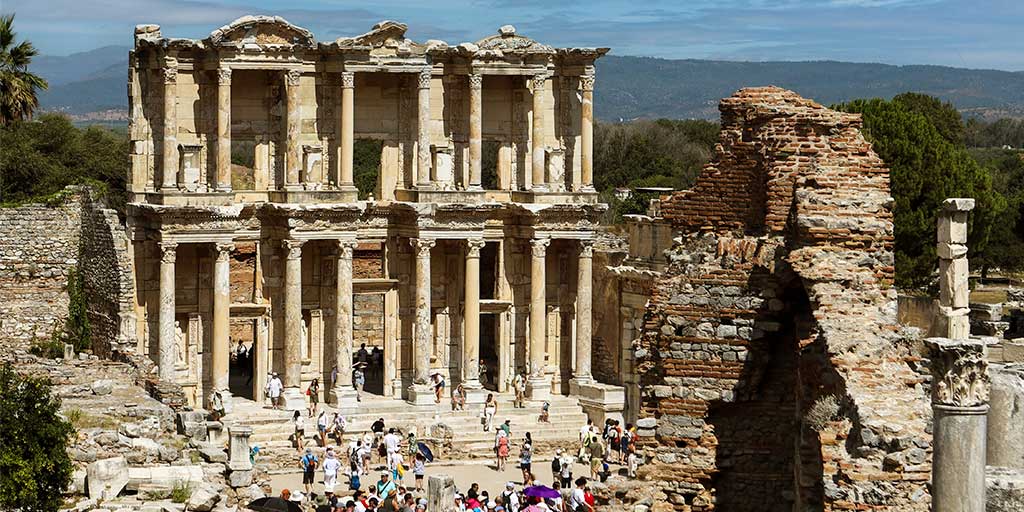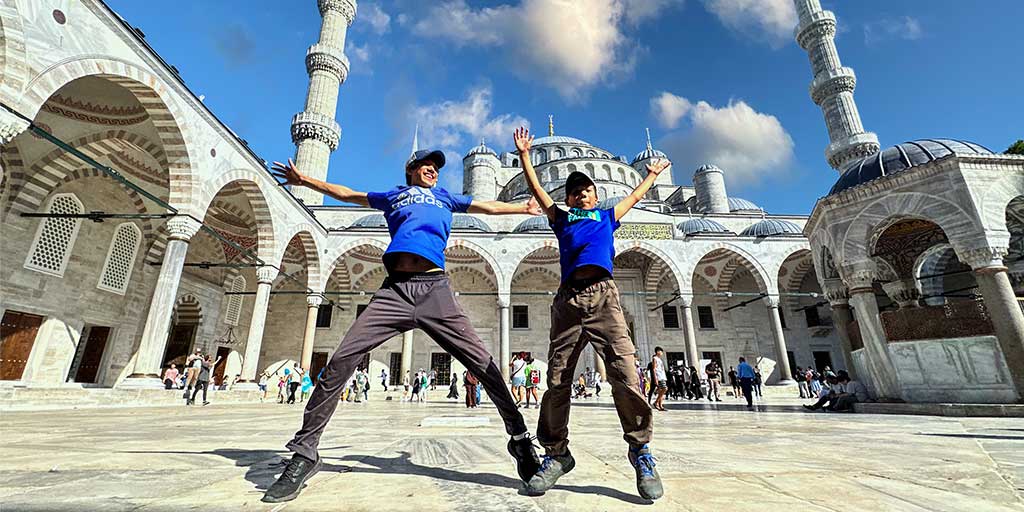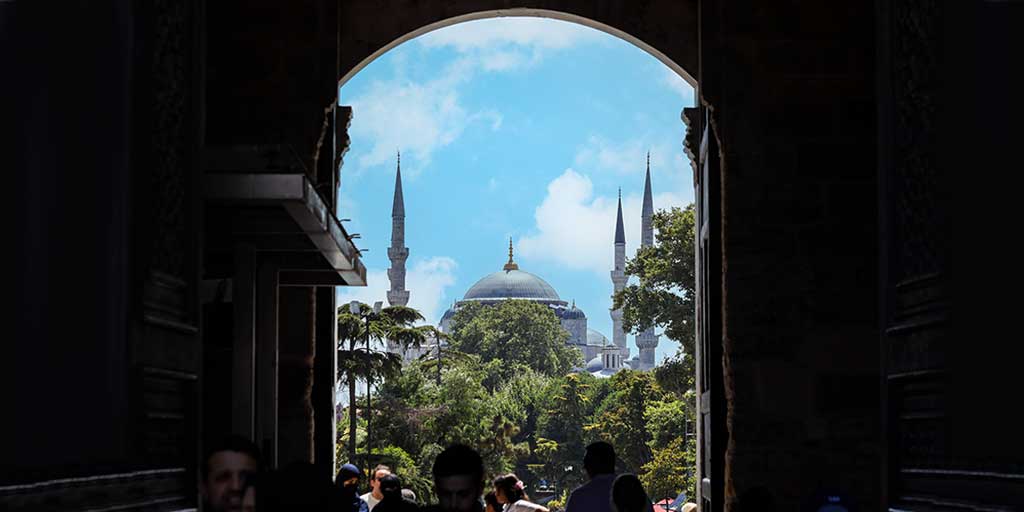The small town of Selcuk, Turkiye is most famous for the dazzling ruins of Ephesus. But there are more things to do in Selcuk than meet the eye.
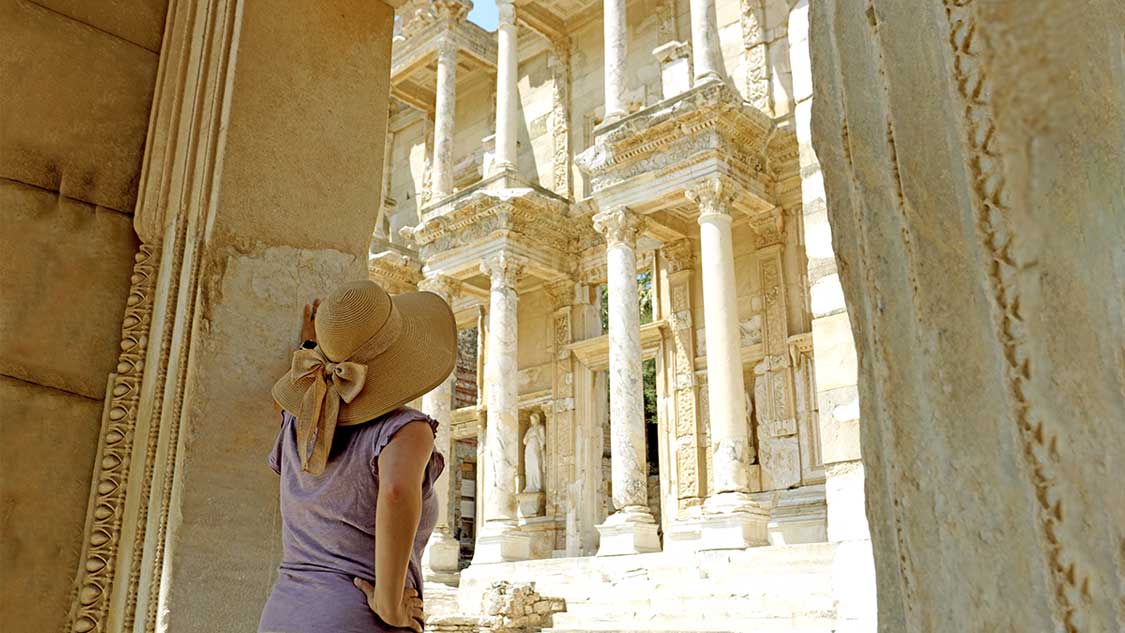
The city of Selcuk is one of the most underrated places to visit in Turkiye. This quiet city, surrounded by farm fields lies just 50 minutes from the major city of Izmir and is most famous for its proximity to the stunning ruins of Ephesus. But there is much more Selcuk, Turkiye than meets the eye.
With a population of less than 40,000 and a largely agricultural workforce, Selcuk slips under the radar of most people who travel to Turkiye. The town’s largest crowds come from cruise ship tours that make a side trip to the Ephesus Archaeological Museum from the famous ruins of Ephesus one city over.
But I’m going to let you in on a little secret.
Selcuk is pretty incredible on its own. And it holds a secret that very few people know about.
If all you’re looking to do in Selcuk is explore Ephesus, that’s ok too. You can find our complete guide to the Ephesus ruins here.
About Selcuk, Turkiye
Table of Contents
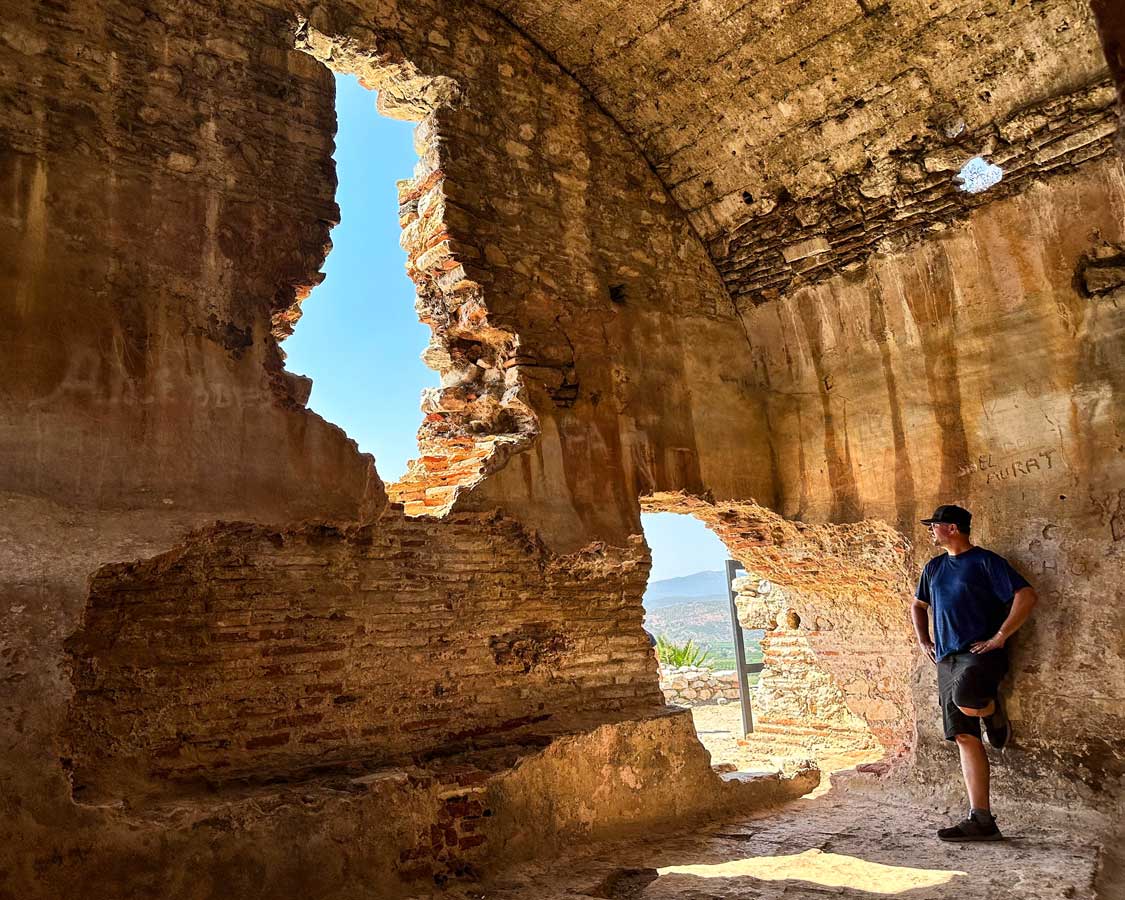
The town of Selcuk, Turkiye has a rich history. The town was named for the Seljuk Turks who ruled this region in the 12th Century. While ancient architecture from the Ottoman and Byzantine Empires still dot the region, they’re blended seamlessly with modern buildings that are sprinkled through the narrow streets.
Selcuk is surrounded by beautiful landscapes that combine a patchwork of olive groves and agricultural fields, offering a wonderful escape for those who love hiking, nature, and the outdoors.
Beyond its natural beauty, the quiet town of Selcuk played an important role in history, especially for early Christianity. This town was home to a great Ancient Greek city. In fact, it was here, in 550 BC, that Croesus, the King of Lydia, ordered Artemesia to be built. This massive temple, known famously as the Temple of Artemis, would go on to be ranked one of the Seven Wonders of the Ancient World.
Later, both John the Baptist and Mary, the mother of Jesus, would spend their final days near the town of Selcuk. Both of these Christian Saints have monuments built in their honor nearby.
Selcuk is one of the most underrated destinations in Turkiye. It’s shocking how few people visit. Those who do are usually on a tour that combines destinations like Ephesus and the Pamukkale geothermal terraces. And even they rarely spend more than a few short hours in Selcuk.
Considering traveling to Turkiye? Check out our Turkiye family travel blog before you go.
The Best Things To Do In Selcuk
If you’re spending some time in the city and looking for incredible things to do in Selcuk, you’re in luck. The town is packed with attractions, and because Selcuk is such a small town, it’s very easy to get around and see them all.
Here’s our list of the top attractions in Selcuk to help you get started.
Ephesus
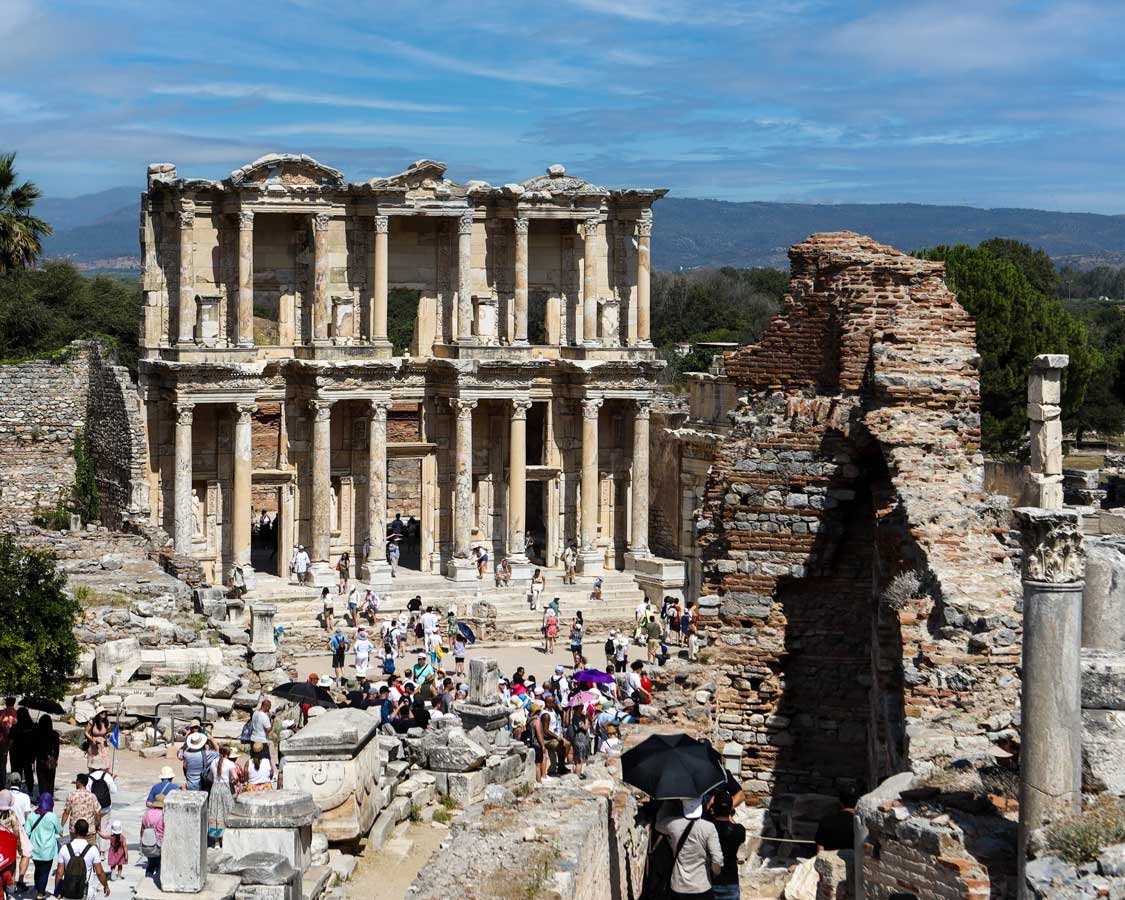
Ephesus is the most popular place to visit in Selcuk and one of the most visited places in Turkiye. This is all for good reason.
This ancient city had its Greek roots planted in the 7th century BC, but its ancient history lies far beyond that. The city was built upon the site of an ancient Attic-Ionian colony that dates WAY back to the 10th century BC. The city later transferred to Roman rule around 100 BC.
Ephesus, Turkiye blossomed to a population of around 250,000 residents, making it one of the largest cities in the Mediterranean. It also boasted one of the most advanced aqueduct systems in the world for its time.
It’s believed by many scholars that Ephesus was the city in which the Gospel of John was written, sometime between 90 and 100 CE, around the time when most of the surviving buildings in Ephesus were built.
Ephesus is a UNESCO World Heritage Site and is home to some of Turkiye’s most famous attractions, including the grand Library of Celsus, one of the largest Roman libraries that once housed more than 12,000 books and manuscripts.
Ephesus is one of the largest archaeological ruins in Turkiye, yet it is believed that only about 15% of the city has been excavated. Along the cobblestone streets, you’ll find the Terrace Houses, where the city’s elite had their homes, the Temple of Hadrian, and two beautiful amphitheaters.
While many of the greatest pieces of art in Ephesus have been moved to the archaeological museum in Selcuk or to other museums around the world, you’ll still find many beautiful pieces still hanging where they originally did.
Having a guide in Ephesus will help you understand all of the best parts of this ancient city. This small group tour lets you skip the line at Ephesus and departs from either Kusadasi or Selcuk.
If you don’t opt for a tour, there is a shuttle that departs from the Ephesus Museum in Selcuk that takes visitors to the upper entrance in Selcuk. It’s a tight ride but very inexpensive. There are also taxis that shuttle visitors between Ephesus and Kusadasi.
You can find our complete guide to visiting the Ephesus ruins here.
Temple of Artemis
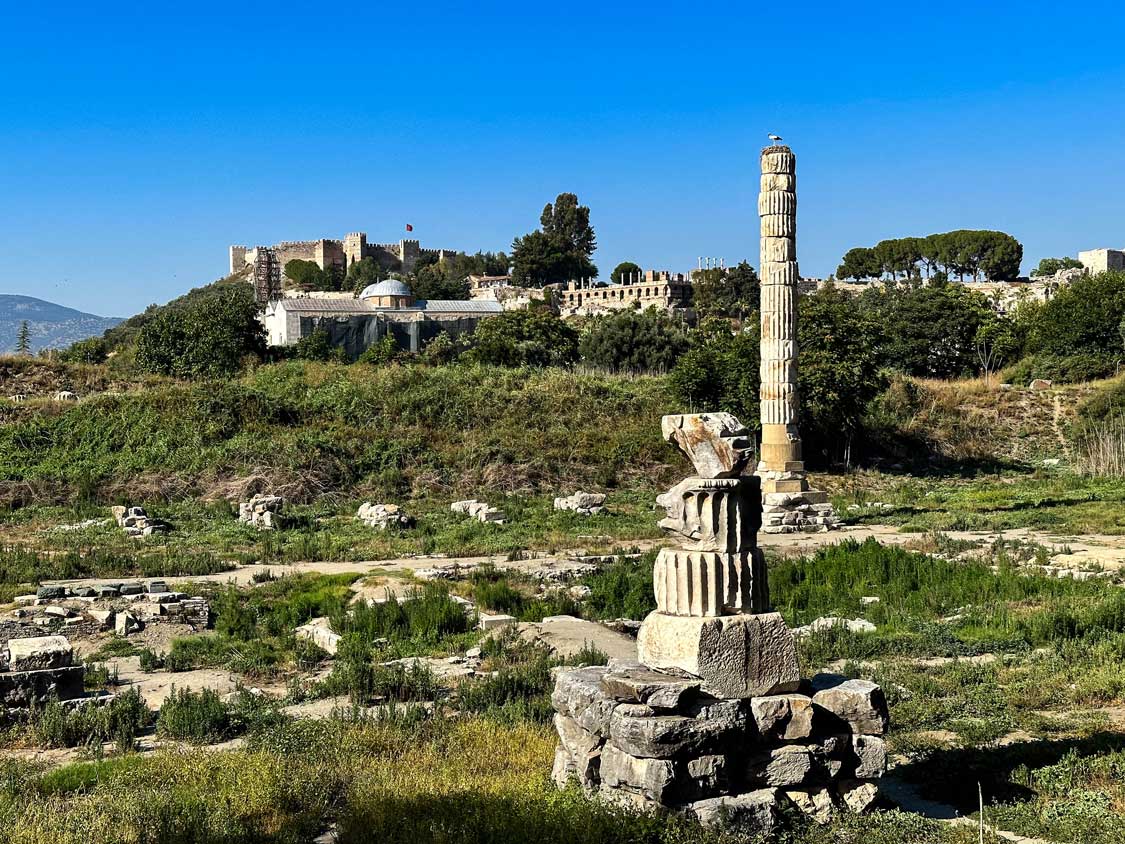
A visit to the Temple of Artemis, or Artemesia, is one of the best things to do in Selcuk. Once a grand temple to the Greek Goddess Artemis, little remains of the temple’s original majestic halls. But the Temple of Artemis was once considered to be one of the Seven Wonders of the Ancient World, and for that alone, it’s worth the visit.
Of the original Seven Wonders of the Ancient World, only the Pyramids of Giza in Egypt remain standing. Of the remaining six, Selcuk and the Temple of Artemis is one of the few places where you can still see remnants of the original building.
In its prime, the Artemesia was a stunning monument to Artemis, who in Roman times was referred to as Diana. She was the Goddess of Fertility, and her influence continues in the region, as you’ll find egg statues and references throughout the ruins of Ephesus.
The Temple was commissioned by Croesus, the King of Lydia, before 550 BCE and was infamously burnt to the ground in 356 BC. The temple was rebuilt but eventually destroyed by Goth invaders in 262 CE. The temple was made entirely of marble and covered a massive 350 by 180 feet (about 110 by 55 meters). It featured 127 columns.
Of those columns, only one remains standing at the site, while half of another remains. There are fragments that sit in the British Museum in London. However, the site itself was looted thoroughly to build nearby temples and mosques.
Make sure to include a visit to the Ephesus Archaeological Museum, which includes scale models of what the original Temple of Artemis looked like at its height.
Ephesus Archaeological Museum
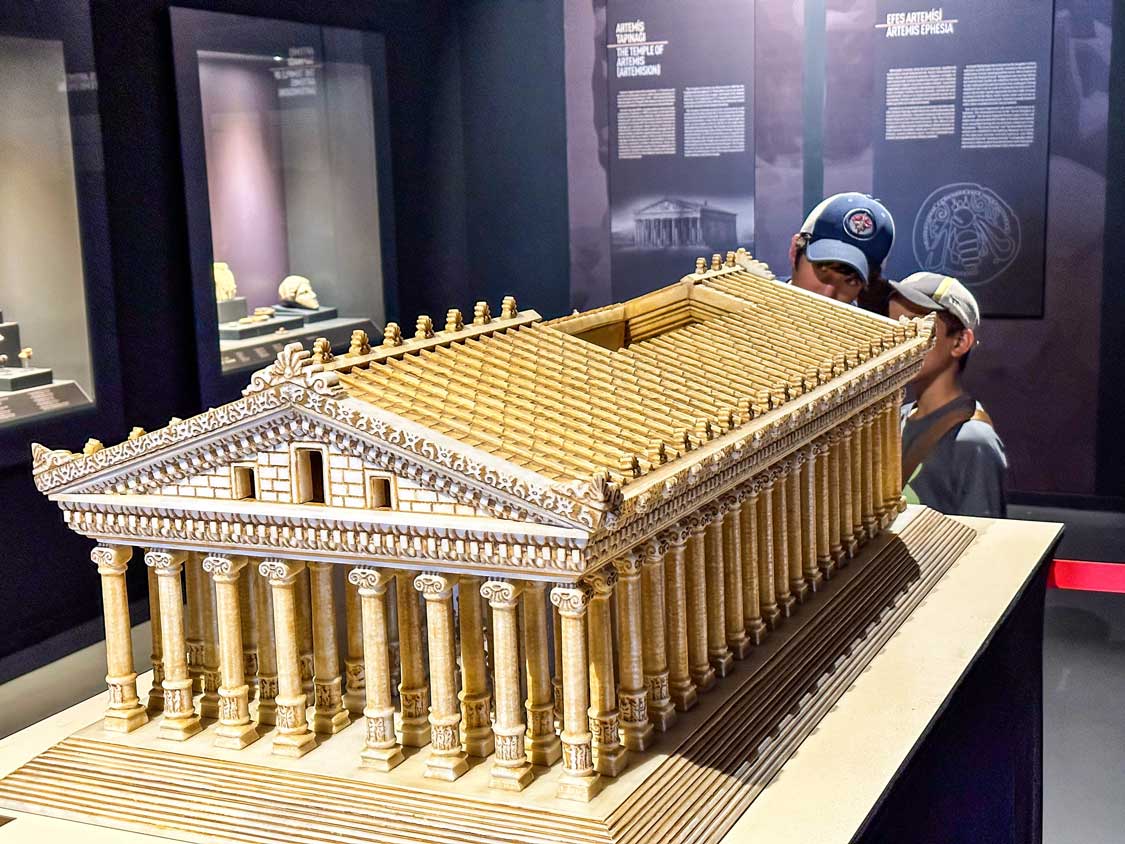
Right in the heart of Selcuk is the Ephesus Archaeological Museum. This small but fascinating museum is missed by many visitors to Selcuk. But those who don’t head straight to and from Ephesus will discover some of the best-preserved Roman and Greek ruins anywhere.
Some of the highlights of the Ephesus Archaeological Museum include statues of Artemis as well as relics from St. John’s Tomb and Basilica and the Ayasuluk Fortress.
One thing that my family and I found fascinating was the difference between the sculptures that were carved by the masters and the ones carved by the students. If you visit, I’ll just say that the difference lies in the faces, and we got a bit of a giggle out of them.
The museum is open from 8:00 a.m. to 8:00 p.m. from April to October and from 8:30 a.m. to 5:30 p.m. from November to March.
House Of Virgin Mary
Christian pilgrims are among the top visitors to the town of Selcuk as the town is home to two of the most important religious sites in Christianity, the House of the Virgin Mary and the Basilica of St. John.
The House of the Virgin Mary sits on a hill called Mt. Koressos. This small stone house is believed to be where Mary, the mother of Jesus, spent her last days. The authenticity of the house has never been confirmed by the Catholic Church, but several popes, including John Paul II and Paul VI, have visited.
The House of the Virgin Mary is entered via a key-hole-shaped baptismal pool that’s larger than the one in Ephesus. It features one large room where an altar and a statue of the Virgin Mary are displayed at the center.
The site is about five miles (8 km) from the Ephesus Archaeological Museum. You can rent a car or hire a taxi to reach it. Alternatively, you can join an Ephesus tour that includes the House of the Virgin Mary.
Ayasuluk Castle
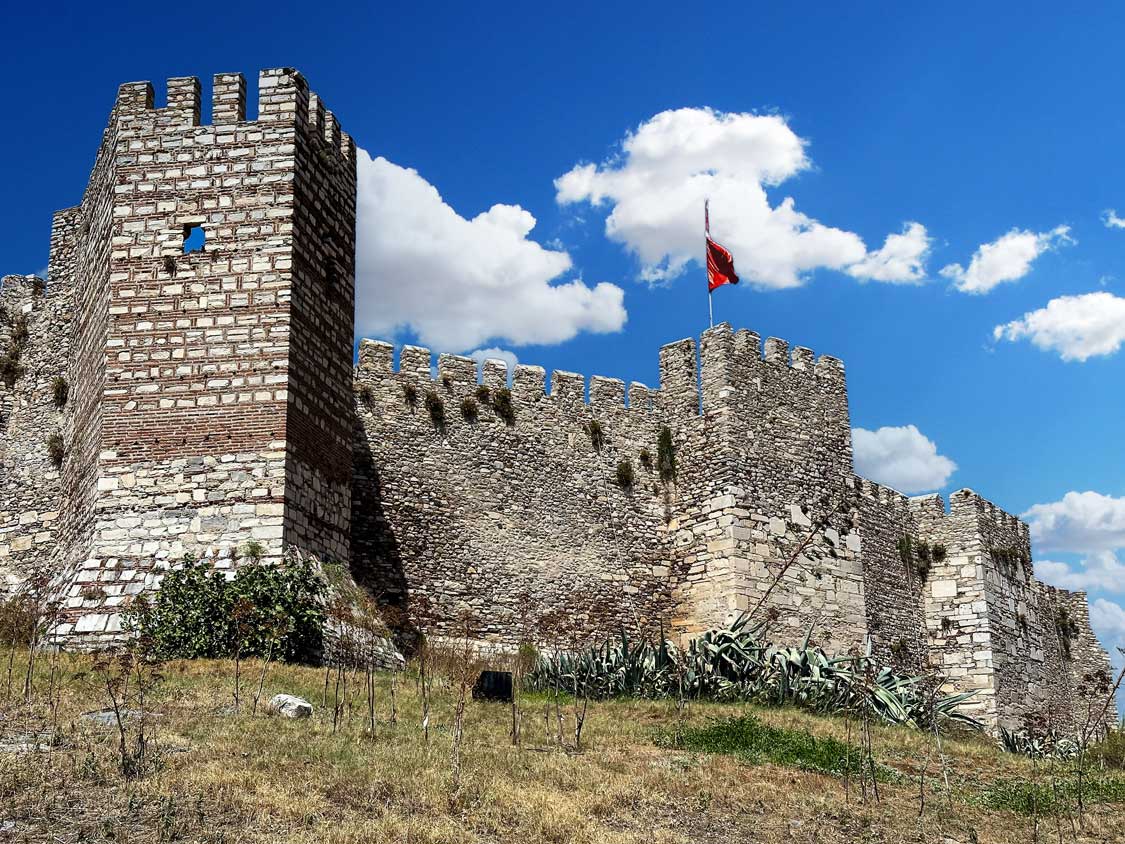
The ancient city of Ephesus is not the only impressive ruin in Selcuk. Walking distance from the city center lies the remains of Ayasuluk Castle.
Also referred to as “Selcuk Castle,” Ayasuluk Castle sits prominently on Ayasuluk Hill overlooking the town of Selcuk. Its towering position gave the castle commanding views over the town and nearby landscape.
Its strategic importance led to many colonies and fortresses have been built here since the Bronze age (2000-3000 BC). What remains are the remnants of the current castle date to around 650 CE. The fortification was built to protect the town of Selcuk and the tomb of St. John, which lies within.
Ayasuluk Castle is open from 8:00 a.m. to 7:30 p.m. from April to October and from 8:30 a.m. to 5:30 p.m. from November to March.
Tomb of Saint John
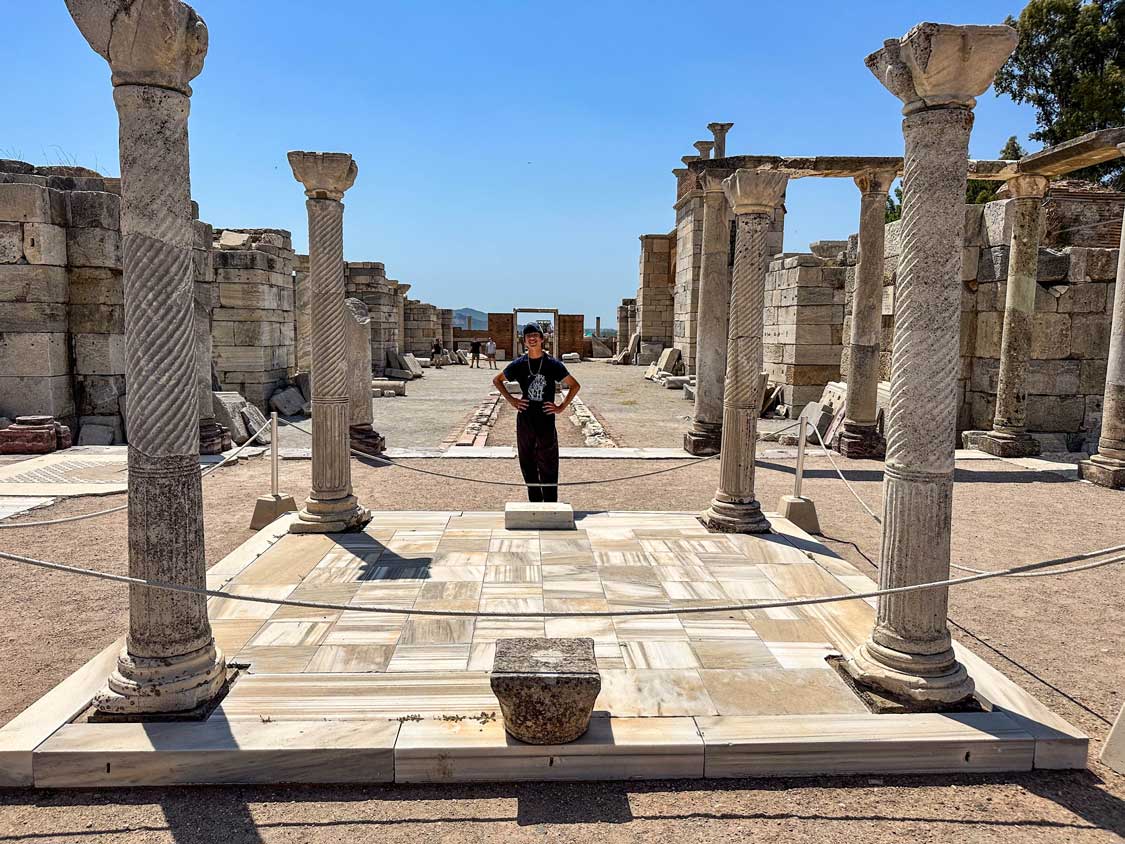
The Virgin Mary is not the only Christian saint to have spent their final days in Selcuk. Saint John, also known as John the Baptist spent the final years of his life here in exile after escaping Roman persecution. He was buried on Ayasuluk Hill. A tomb and a monumental basilica were built by Emperor Justinian hundreds of years later.
It’s believed that John wrote the Gospel of John, one of the books of the Christian bible, in Selcuk prior to his death.
Little remains of the original basilica, but the tomb of Saint John can still be visited. It’s covered by a beautiful marble patchwork with four distinct columns in each corner. There’s also a small plaque commemorating the location.
Grotto of Seven Sleepers
Selcuk is home to one of the most fascinating stories told in both the Islamic Quran and the Christian Bible. The story is of the “Seven Sleepers” My family was visiting a small mosque in Selcuk when a local Imam took us aside and shared the story with us.
The story tells of seven young Christian soldiers in 250 CE who were facing religious persecution from the Roman Empire. Fearing for their lives, the seven boys hid in a cave to protect themselves from being forced into pagan sacrifices. The seven fell into a sleep.
The cave was unsealed by soldiers serving Roman Emperor Theodosius II 300 years later. At this point, the seven boys awoke. and shared their story and its meaning before dying. Emperor Theodosius II was so moved by it that he ordered their remains to be enshrined and absolved all bishops who had been persecuted for believing in the Resurrection.
There is no concrete proof that the Grotto of the Seven Sleepers is the actual cave in which the boys were entombed, but it’s widely believed to be the one. Some believe the location is close to the entrance to Ephesus, others believe it lies right in the town of Selcuk itself.
Taxis and horse carriages are the best way to reach the grotto. It’s an easy visit and you won’t need a tour.
Belevi Mausoleum
One of the most fascinating places to visit in Selcuk lies in Belevi, about 15 minutes from town. This colossal tomb was the second-largest tomb in the world at one point. It was modeled after the Mausoleum of Halicarnassus in, what is now, Bodrum. The give you an idea of the grandeur, the Mausoleum of Halicarnassus was one of the Seven Ancient Wonders of the World.
Belevi Mausoleum is believed to have been built around 333 BC as a burial tomb for Lysimachus, one of the successors of Alexander the Great.
While much of the tomb has been destroyed over the subsequent two thousand years, the massive pyramid-shaped base is still prominent.
The mausoleum was modeled after the Mausoleum of Halicarnassus and is in much better shape than its larger sister. So if you wanted to get a better idea of how it would have looked, a visit to the Belevi Mausoleum is a great place to start.
Mosque of Isa Bey
While it’s currently closed for renovations, the Mosque of Isa Bey is still one of the top things to do in Selcuk.
With its unique Seljuk architecture, the Isa Bey Mosque is an excellent example of the building style of the late 14th century. The mosque’s towering walls are built of marble and limestone and the interior features a vast courtyard and prayer hall.
During our visit, the Mosque of Isa Bey was undergoing a significant renovation and looked to be closed for some time.
Storks of Selcuk
During our visit to Selcuk in August we missed the Selcuk Storks, but if you’re visiting the city between March and July you’ll likely see the town’s famous storks nesting on rooftops, chimneys, and electrical poles throughout the city.
Pamucak Beach
Situated just a ten-minute drive from Selcuk, Pamucak Beach is a wonderful getaway from the ancient sites. There are minibusses that leave for the beach regularly from across the street from the Ephesus Archaeological Center.
Rent a lounge chair and an umbrella and enjoy some fun in the sun on the Mediterranean coast.
Visiting Selcuk With Kids
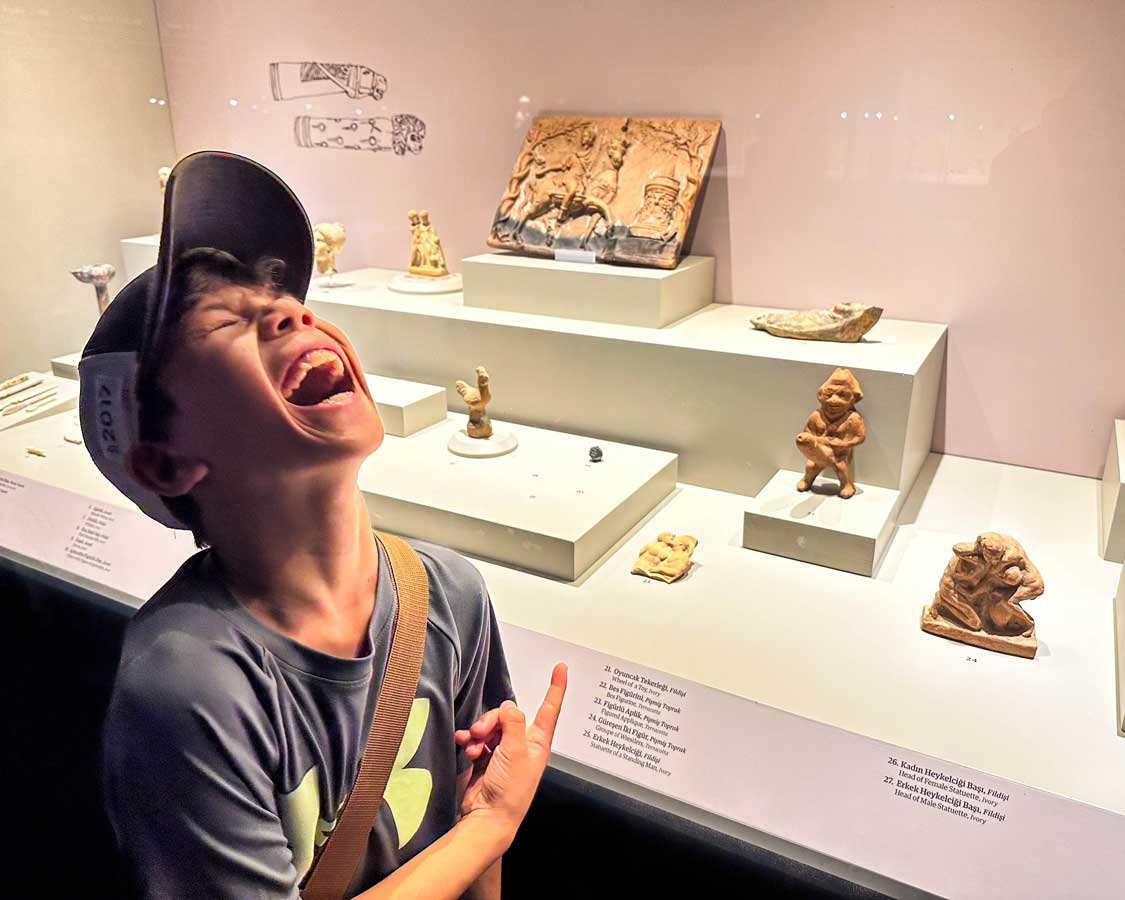
Visiting Selcuk with children is pretty incredible, and it’s far less chaotic than visiting Istanbul with kids. My boys absolutely loved how easy the town was to walk. The locals were very friendly, and the food was, in typical Turkish style, amazing.
Some of the archaeological sites such as Ephesus and Ayasuluk Castle were quite large and lacked shade. If you’re traveling with younger children consider bringing an umbrella or a large hat to help keep the sun off.
A popular getaway for families in Selcuk is the Adaland Aquapark. Unfortunately, the park has a dolphin show, which we do not condone. Dolphins are intelligent creatures and no animals should be used for the entertainment of humans. You can read about how detrimental dolphin shows are here. Please do not visit this attraction.
Where To Stay in Selcuk
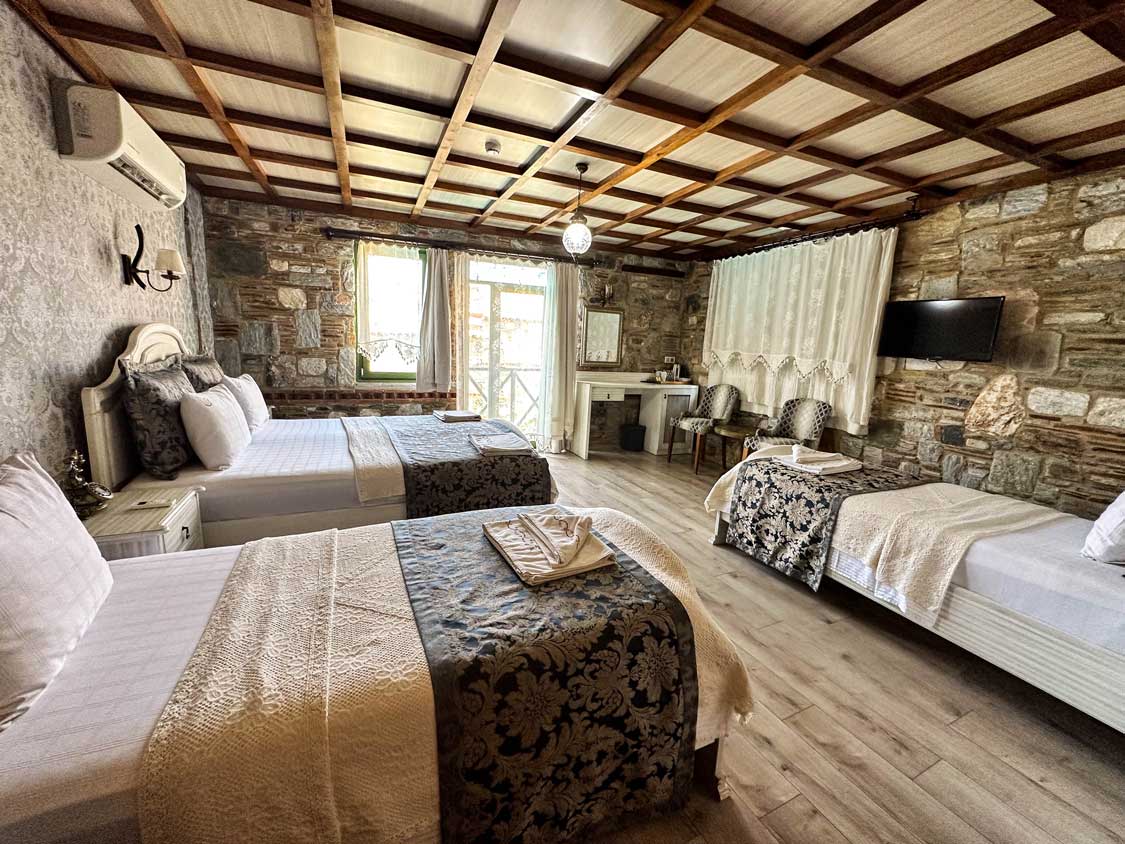
If you’ve got a few days in Selcuk, there are plenty of attractions to keep you busy. It’s a lovely town to spend a few nights in, and there are accommodations for every budget.
We stayed at the Celsus Boutique Hotel, a lovely spot just a five-minute walk from Ayasuluk Castle and the archaeological museum. The rooms were spacious and overlooked a courtyard with a lovely pool.
Another highly-rated Selcuk accommodations include the Nicea Hotel, a more traditional hotel-style accommodation with a continental breakfast and helpful staff.
Hotel Mary’s House is another great family-friendly hotel with a pool located right in the center of town. They feature family rooms and beautiful decor in large rooms. It’s one of the highest-rated hotels in Selcuk.
Tips For Visiting Selcuk, Turkiye
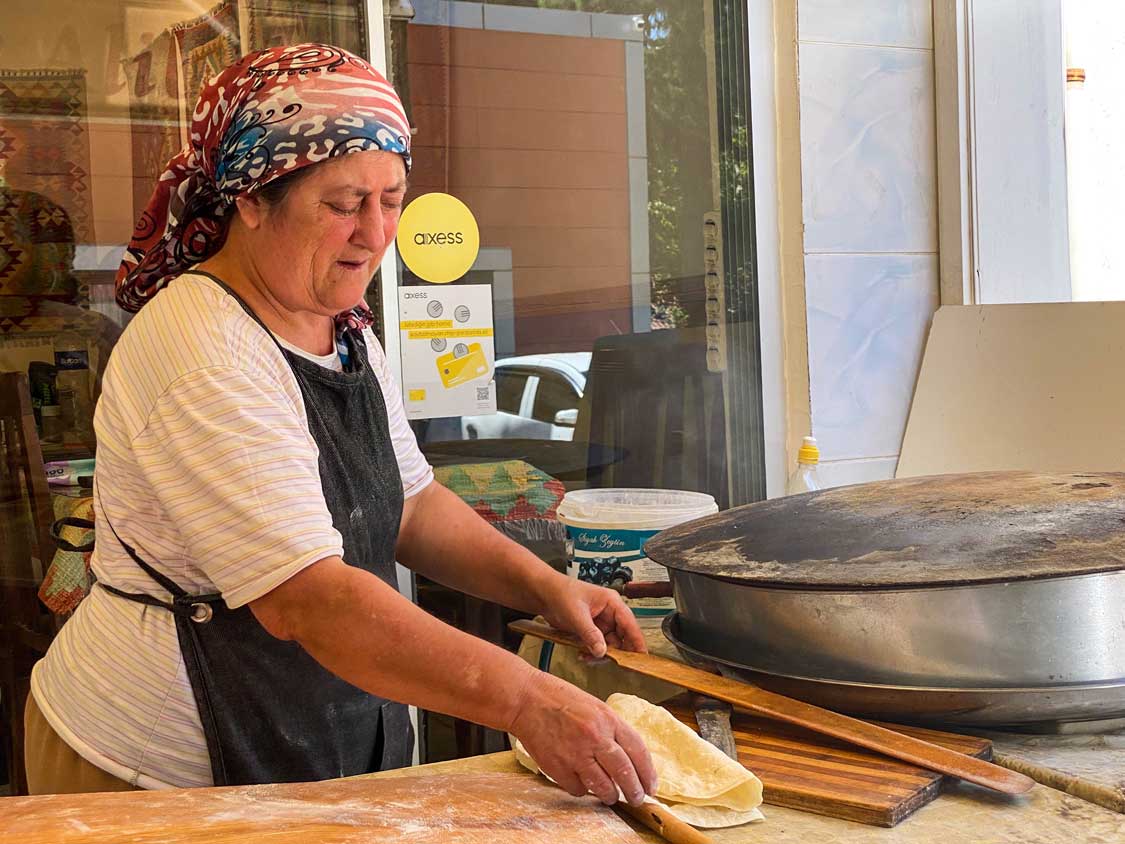
- Getting To Selcuk: You can reach Selcuk by air from Istanbul. The flight flies to Izmir airport. From Izmir, it’s a 1-hour taxi ride or iZBAN train ride to Selcuk.
- Avoid the Heat and Crowds: Plan your visit to Ephesus and Ayasuluk Castle for the early morning or late afternoon to avoid the heat and crowds, especially in the summer. Ephesus is located close to the cruise port of Kusadasi and attracts many cruise-ship tourists on day trips. You can read about our Aegean Sea cruise that docked in Kusadasi here.
- Pack For The Weather: The sun has no mercy, especially during the summer. Don’t forget sunscreen, a hat and sunglasses. Water is sold inside at a premium, so it would be wise to bring some of your own.
- Wear the Right Shoes: Exploring Selcuk and Ephesus requires a lot of walking. This isn’t the time to dress for fashion; instead, focus on comfort.
Our Video About Visiting Selcuk and Ephesus in Turkiye
Want to dive more into the experience of visiting Selcuk and Ephesus in Western Turkey? Check out our video showcasing everything that we got up to.
Tips For Family Travel In Turkiye
Family travel in Turkiye, especially in places like Sanliurfa and the Southeast, requires some planning and a little bit of luck. Some areas of this country can be closed due to political unrest, so it’s always a good idea to check out current travel advisories and stay informed of the current travel status.
Check out our Turkiye Family Travel Blog for everything that you need to know about family travel in Turkiye, and watch our Tips for Family Travel in Turkiye video below to help you plan an unforgettable visit to this mesmerizing and wonderful country.
You’d be doing us a huge favor if you could hit the like and subscribe buttons.
Enjoy Your Time Exploring Selcuk, Turkiye
Selcuk was one of our favorite hidden gems in Turkiye. This small town is home to many world-class attractions including Ephesus and the Temple of Artemis. I hope that our complete guide to visiting Selcuk has helped you to plan your visit. Don’t hesitate to drop a comment or reach out if there’s something that we missed.
Don’t miss our Turkiye Family Travel Blog for all of the information you need for family travel in the country.
If you love family travel as much as we do, please join our Family Travel Support Group on Facebook. You can connect with more family travelers just like you who love to explore the world.
Wandering Wagars is a participant in the Amazon Services LLC Associates Program, an affiliate advertising program designed to provide a means for sites to earn advertising fees by advertising and linking to amazon.com, amazon.co.uk, amazon.ca. Amazon and the Amazon logo are trademarks of Amazon.com, Inc. or its affiliates
You May Also Like To Read:


